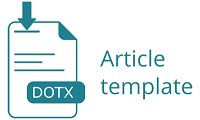Effectiveness of Ring Card as a Promotive Effort For Mothers Under Two Years in Stunting Prevention
Abstract
One of the nutritional issues in toddlers who need attention both at home and abroad at this time is Indonesia is stunting. Included in the third country with the highest prevalence in Southeast Asia. In 2017 the number of toddlers in the world who experienced stunting was as much as 22.2% or about 150.8 million. Stunting is a very short state of the body in accordance with the standard WHO-MGRS standard with another definition is disruption of physical growth and brain development, which can affectability and achievement, productivity, and creativity in the productive age. One of the prevention carried out by The government so that Indonesian children can grow and develop optimally, accompanied by emotional, social, and physical abilities that are ready to learn, innovate and compete at the global level. One of the efforts that can be done to prevent stunting is to provide information to the mother or family through interesting health media. Ring Card is one of the easy-to-carry media, with the use of interesting colors and images containing applicable material so that it is expected that the knowledge, attitude, and skills of mothers can be improved. Research Methods used that are experimental quasi with pre-post design in 30 toddlers mothers. In The Practice of Independent Midwives of West Bandung Regency, the data analysis test used is the Wilcoxon test, Paired T-Test. The results obtained are: there is a difference in the increase in pre-test 10.50 to 15.00 with a value of p 0.000 (p<0.05), while the attitude variable is obtained that there is an increase in the mean value from 22.31 to 25.71, with a value of p 0.000 (p<0.05). and in skill variables, there is an increase in the median from 85.00 to 100.00, with a value of p 0.000 (p<0.05). The conclusion of this study the use of ring cards proved effective as a promotive effort in the toddler’s mother in the prevention of stunting.
Keywords
References
Alfiridsyah, Ichsan, & Miko Ampera. (2013). WHO-2006 TERHADAP PENINGKATAN PENGETAHUAN DAN PENILAIAN STATUS GIZI PADA TENAGA GIZI PELAKSANA DI KOTA BANDA ACEH TAHUN 2009 ( Different Use of New Standards WHO Anthropometry-2006 to Increasing Knowledge and Assessment on Nutrition Status for. Buletin Penelitian Sistem Kesehatan, Vol. 16 No, 143–153.
Aridiyah, F. O., Rohmawati, N., & Ririanty, M. (2015). Faktor-faktor yang Mempengaruhi Kejadian Stunting pada Anak Balita di Wilayah Pedesaan dan Perkotaan (The Factors Affecting Stunting on Toddlers in Rural and Urban Areas). E-Jurnal Pustaka Kesehatan, 3(1), 163–170.
Arnita, S., Rahmadhani, D. Y., & Sari, M. T. (2020). Hubungan Pengetahuan dan Sikap Ibu dengan Upaya Pencegahan Stunting pada Balita di Wilayah Kerja Puskesmas Simpang Kawat Kota Jambi. Jurnal Akademika Baiturrahim Jambi, 9(1), 7. https://doi.org/10.36565/jab.v9i1.149
Arsyati, A. M. (2019). PENGARUH PENYULUHAN MEDIA AUDIOVISUAL DALAM PENGETAHUAN PENCEGAHAN STUNTING PADA IBU HAMIL DI DESA CIBATOK 2 CIBUNGBULANG Pendahuluan. 2(3), 182–190.
Azria, C. R., & Husnah, H. (2016). Pengaruh penyuluhan gizi terhadap pengetahuandan perilaku ibu tentang gizi seimbang balita kota banda aceh. Jurnal Kedokteran Syiah Kuala, 16(2), 88–94.
Jalal, F. (2017). Penanggulangan Stunting dan Peningkatan Mutu Pendidikan Sebagai Contoh Upaya Pencapaian Tujuan SDGS. 28.
Kemenkes RI. (2010). Strategi Peningktan Makanan Bayi dan Aank(PMBA). Kemenkes RI.
Kemenkes RI. (2018). Buletin Stunting. Kementerian Kesehatan RI, 301(5), 1163–1178.
Kementerian Kesehatan Republik Indonesia. (2018). Warta Kesmas - Cegah Stunting Itu Penting. Warta Kesmas, 1–27.
Lamid, A., Almasyhuri, A., & Sundari, D. (2015). Pengaruh proses pemasakan terhadap komposisi zat gizi bahan pangan sumber protein. Media Penelitian Dan Pengembangan Kesehatan, 25(4), 20747.
Luh Dila Ayu Paramita, Ni Luh Putu Shinta Devi, P. O. Y. N. (2021). HUBUNGAN PENGETAHUAN DAN SIKAP IBU MENGENAI STUNTING DENGAN KEJADIAN STUNTING DI DESA TIGA, SUSUT, BANGLI Luh. 9(3), 323–331.
Mariani, N. N., Hendarman, H., & Nita, G. S. (2016). Faktor-Faktor yang berhubungan dengan pemberian MP-ASI dini di wilayah kerja UPTD Puskesmas Sindanglaut Kecamatan Lemahabang Kabupaten Cirebon. Jurnal Kesehatan, 7(3), 420–426.
Millennium Challenge Account Indonesia. (2013). Stunting dan Masa Depan Indonesia. Millennium Challenge Account - Indonesia, 2010, 2–5.
Nining, Y. (2014). Hubungan tingkat pendidikan ibu dan pemberian asi eksklusif dengan kejadian. Program Studi Ilmu Gizi Fakultas Ilmu Kesehatan Universitas Muhammmadiyah Surakarta, 4–10.
Notoatmojo, S. (2007). Promosi Kesehatan dan Ilmu Perilaku. Jakarta: Rineka Cipta.
Nugrahaeni, D. E. (2018). Pencegahan Balita Gizi Kurang Melalui Penyuluhan Media Lembar Balik Gizi. Amerta Nutrition, 2(1), 113. https://doi.org/10.20473/amnt.v2i1.2018.113-124
Olsa, E. D., Sulastri, D., & Anas, E. (2018). Hubungan Sikap dan Pengetahuan Ibu Terhadap Kejadian Stunting pada Anak Baru Masuk Sekolah Dasar di Kecamanatan Nanggalo. Jurnal Kesehatan Andalas, 6(3), 523. https://doi.org/10.25077/jka.v6i3.733
Pratiwi, I. G., & Wahyuningsih, R. (2018). Risk Factors of Stunting Among Children in Some Areas in Indonesia: A Literature Review. International Journal of Studies in Nursing, 3(3), 41. https://doi.org/10.20849/ijsn.v3i3.468
Rahmandiani, R. D., Astuti, S., Susanti, A. I., Handayani, D. S., & Didah. (2019). Hubungan Pengetahuan Ibu Balita Tentang Stunting Dengan Karakteristik Ibu dan Sumber Informasi di Desa Hegarmanah Kecamatan Jatinangor Kabupaten Sumedang Rizkia. Jsk, 5(2), 74–80.
Rohmatun, N. Y. (2014). Hubungan tingkat pendidikan ibu dan pemberian asi eksklusif dengan kejadian stunting pada balita di Desa Sidowarno Kecamatan Wonosari Kabupaten Klaten. Universitas Muhammadiyah Surakarta.
Waliulu, S. H. (2018). Pengaruh Edukasi Terhadap Tingkat Pengetahuan Dan Upaya Pencegahan Stunting Anak Usia Balita. Jurnal Penelitian Kesehatan Suara Forikes, 9(4), 269–272.
Article Statistic
Abstract view : 582 timesPDF views : 283 times
Dimensions Metrics
How To Cite This :
Refbacks
- There are currently no refbacks.
Copyright (c) 2022 Jurnal Kesehatan Prima

This work is licensed under a Creative Commons Attribution-ShareAlike 4.0 International License.




